Try all of this delicious Uzbek food on your trip to Uzbekistan!
Uzbek food is renowned for its rich flavors and diverse influences, reflecting the region’s history as a cultural crossroads along the Silk Road. Uzbekistan offers a rich culinary heritage with a variety of delicious dishes for travellers to try.
Admittedly, I wasn’t feeling that hopeful about the food I was going to try in Central Asia. Uzbek cuisine is not something that I had ever had much exposure to prior to visiting and I assumed it would be… well, boring and average. But I couldn’t be more wrong!
I was very pleasantly surprised by the food culture in Uzbekistan. Deeply rooted in hospitality and tradition, Uzbek meals are often communal and come in generous portions.
Uzbek food culture revolves around home cooking, fresh ingredients from the local bazaar, restaurants that specialise in one dish (which are always better!), bold flavours and lots of herbs and spices. Aromatic herbs and spices such as dill, coriander, cumin and paprika are common in Uzbek cuisine.
Here are some of the foods you need to try when visiting Uzbekistan.
Uzbek food you need to try
Plov
You could call plov Uzbekistan’s national dish. Although it is popular in other post-Soviet countries such as in Kyrgyz cuisine, nowhere is plov taken as seriously as Uzbekistan.
Plov is a rice pilaf made with minced lamb, carrots, onions and spices such as cumin and coriander. It is traditionally prepared in a large kazan over an open fire. Most plov recipes will include fruits like raisins or barberries for sweetness and varying amounts of garlic and oil.
Plov is usually served at special events such as weddings and other large celebrations making it an important dish to Uzbek food culture. Recipes vary from place to place within Uzbekistan and while delicious, can sometimes be quite oily. If you don’t like oily food, I recommend trying the plov in Bukhara where the rice is boiled first making it considerably less oily.
The Central Asian Pilaf Centre is a must visit place in Tashkent. If you go to Tashkent, make sure you stop in and enjoy a plate and see how plov is made.

Please note: Some of these links are affiliate links, meaning I may earn a small commission if you make a purchase (at no extra cost to you)
The best Uzbek street food: Samsa
These savoury pastries are typically filled with minced lamb or beef, onions, and spices. They are a popular and convenient snack and are often found at street stalls, markets and bakeries around the country.
The fillings, shapes and sizes of samsa can vary but they are reliably golden brown, flakey and delicious!


Shashlik
These grilled meat skewers are not all that different to skewered meats you will find all over the world. Shashlik is usually found at outdoor barbecue stands at traditional Uzbek restaurants.
They are usually lamb or beef, but sometimes can be found made with chicken. The meat is marinated in spices and grilled over hot charcoal making them tender and smoky-flavoured.
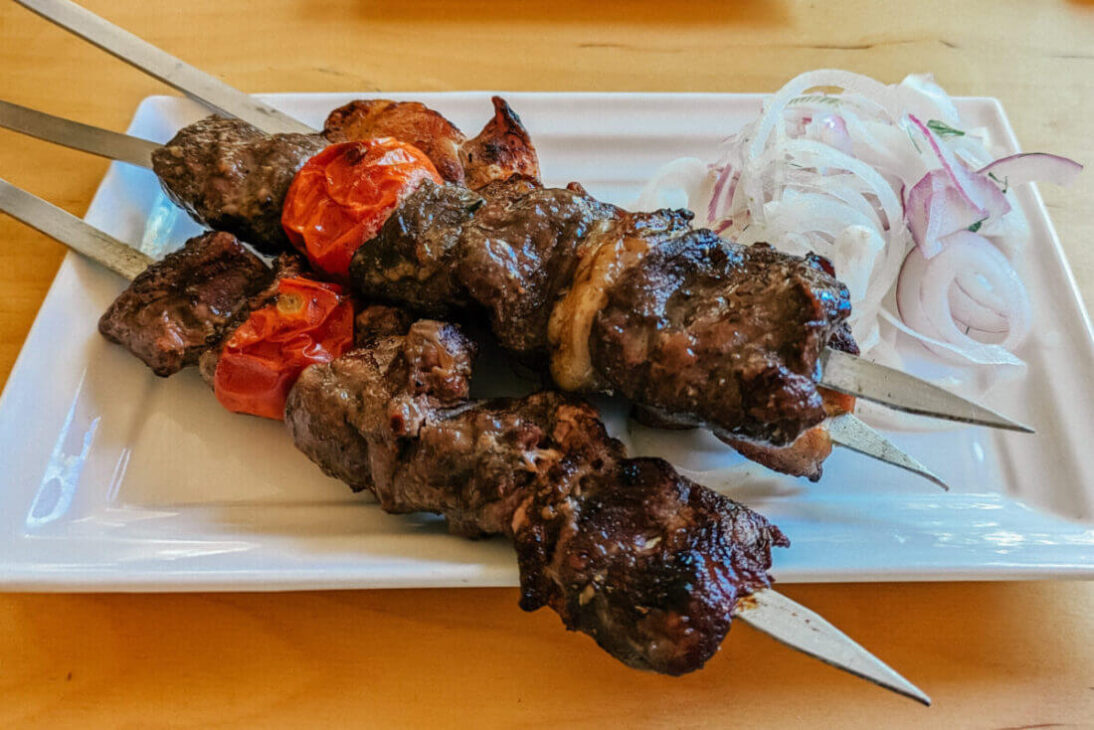
My favourite Uzbek food: Lagman
This hearty noodle soup features hand-pulled noodles served in a savory broth with meat, vegetables and herbs. The best place to try lagman is at local cafes and noodle houses in cities like Tashkent and Samarkand.
Lagman was my favourite Uzbek food. I tried it many times but the best one that I found was at Qorasaroy Lagman near Khast-Imam Square in Tashkent. Qorasaroy Lagman is a local style restaurant which feels like a big food hall. It is close to one of the biggest attractions in Tashkent so there were a couple of other tourists there but it still felt very local.
The noodles were made at the restaurant and had that delicious chewy freshness. They don’t have an English menu but the first item on the menu is lagman – and that’s definitely what you should order here!
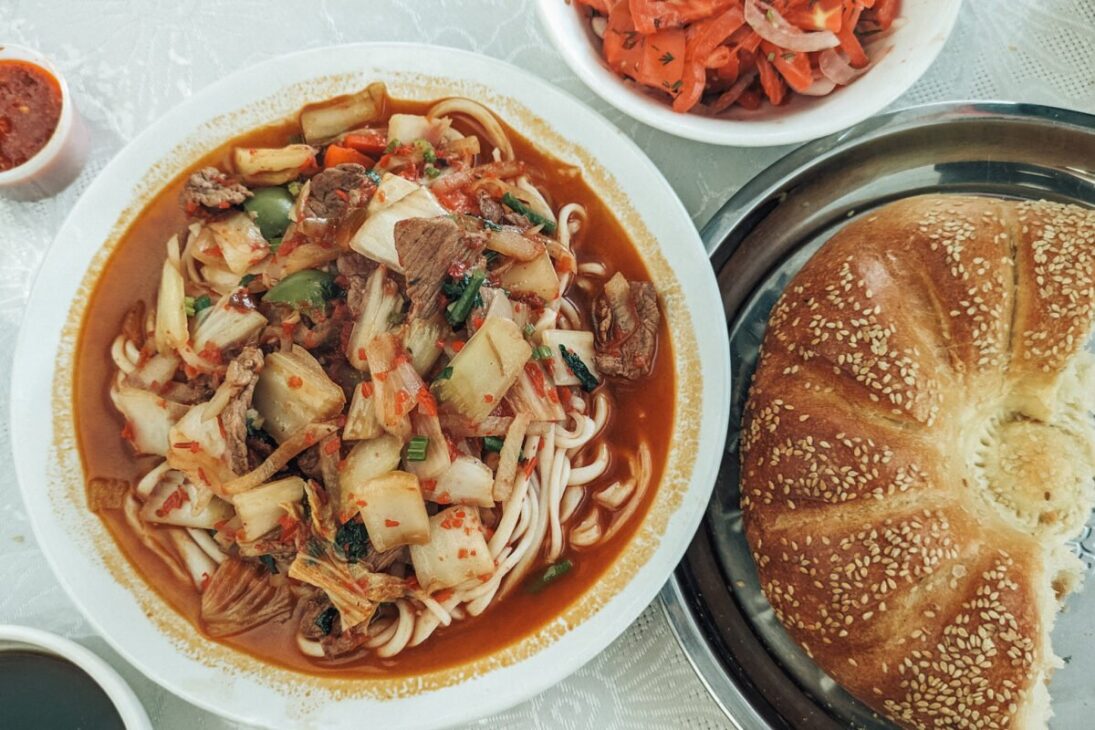
Manti
These steamed dumplings can be found all throughout Central Asia. Manti are usually filled with either beef or lamb meat and onion and steamed. They are typically served with sour cream or yogurt.
Manti is one of the most common Uzbek foods. You can find them at most restaurants serving local food. The great thing about manti is that they will be a little bit different every time you order them, but they are consistently delicious.
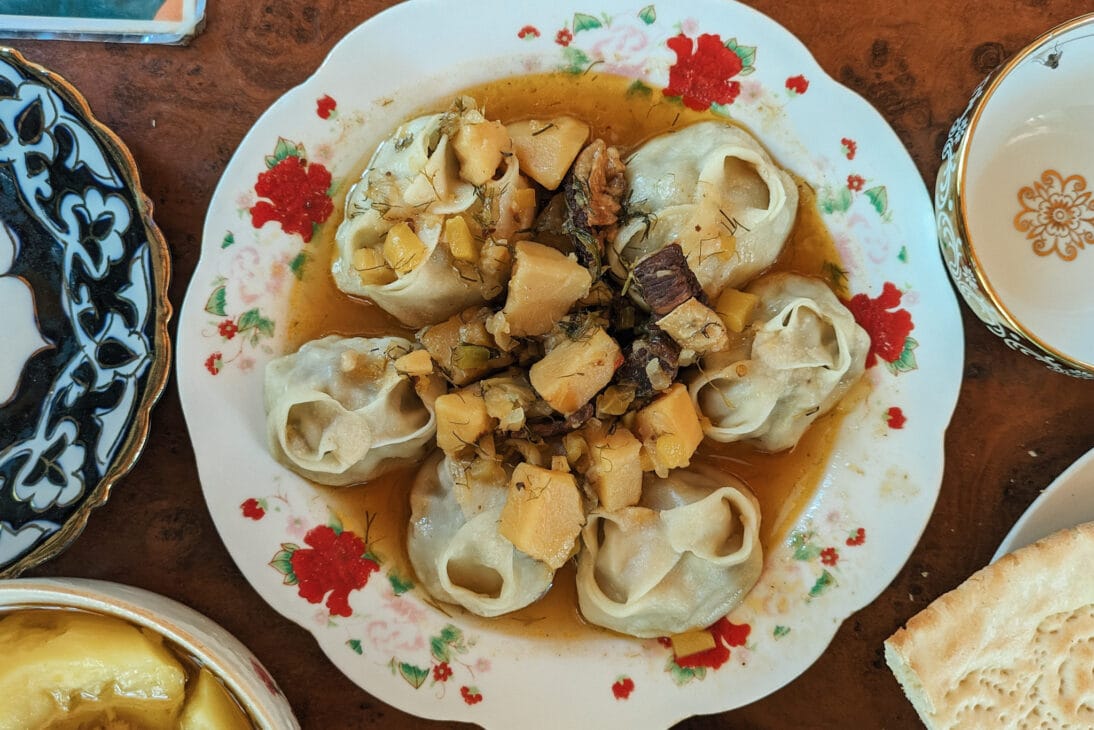
Chuchvara
Chuchvara are similar to manti but smaller. They are the ravioli of Uzbek cuisine, and are sometimes translated as ravioli on English menus.
Chuchvara are filled with lamb or beef and are typically boiled in a bone broth. Fried chuchvara are also common in Uzbek cuisine. They are deep-fried in oil and come served with a sour cream-like sauce.
They are so crispy and delicious! It makes me wonder why we don’t fry pasta more often.
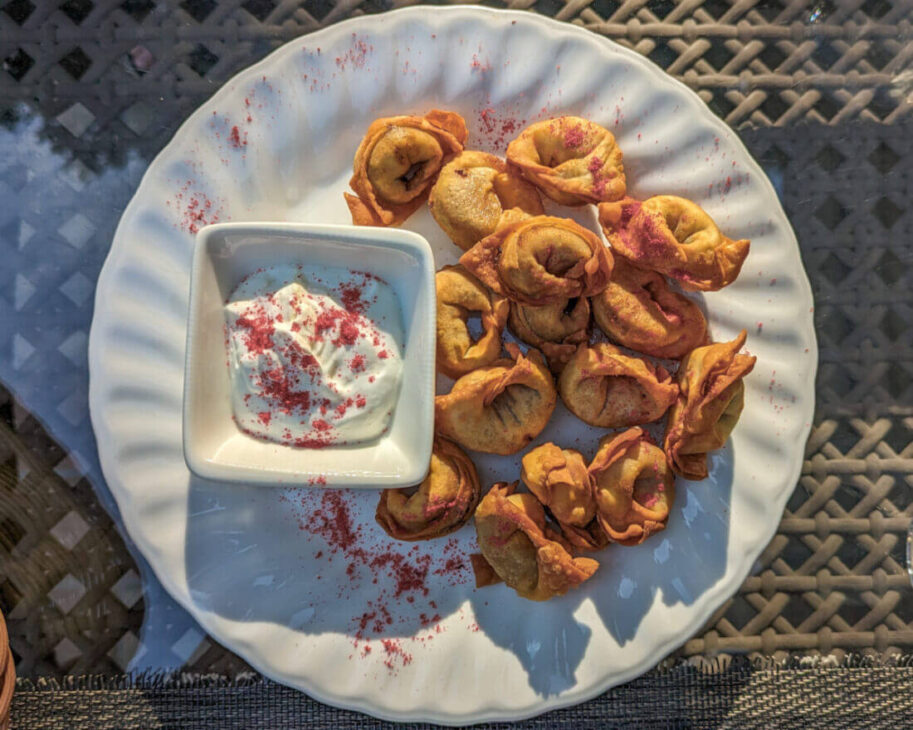
Shivit Oshi
Shivit oshi is a dish native to Khiva although it is possible to find it in other parts of Uzbekistan. Noodles are dyed a bright shade of green by infusing them with fresh dill. The vibrant noodles are then topped with a stew of beef and potatoes and served with a tangy yoghurt.
The best place to try shivit oshi is in Khiva. Most local restaurants will have it on the menu. I only managed to try shivit oshi once at the Terrassa Cafe and Restaurant in Itchan Kala. I really enjoyed how fresh and zesty the noodles tasted. It works perfectly with the hearty stew and yoghurt accompaniments.
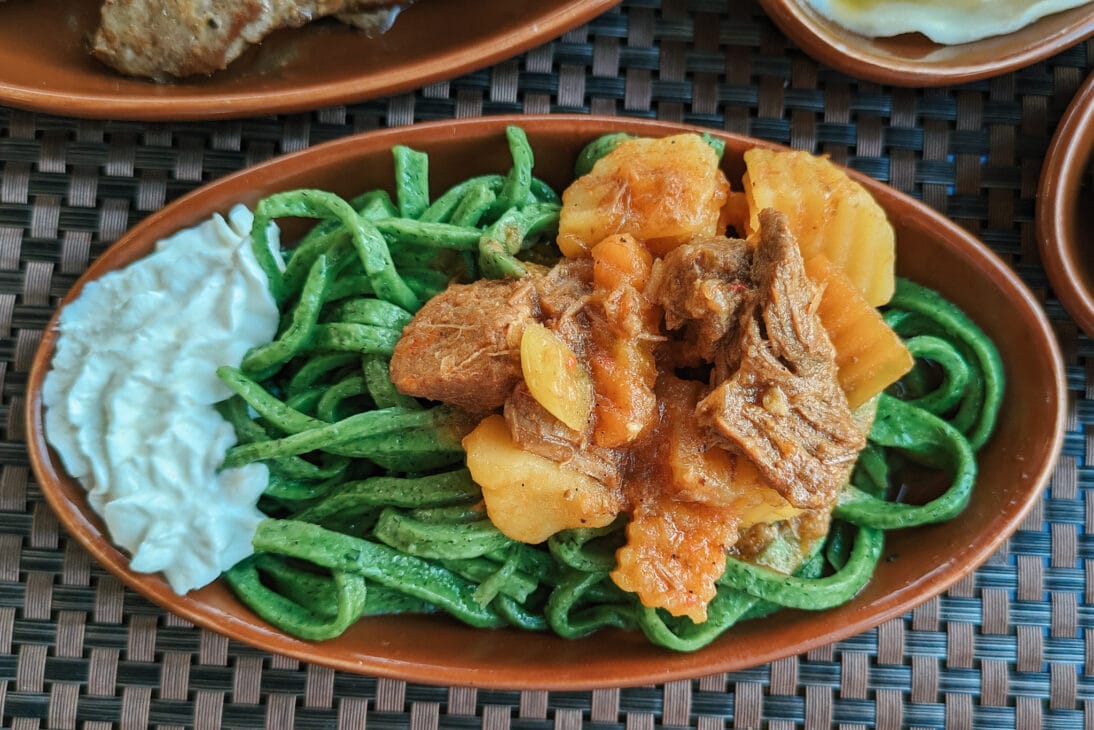
Mastava Uzbek traditional soup
Mastava is a traditional Uzbek soup made from rice, meat (such as lamb or beef), vegetables and sometimes legumes. It is seasoned with various spices such as cumin, coriander, and black pepper, and often garnished with fresh herbs like cilantro or parsley.
Mastava is known for its hearty and comforting nature, similar to an Irish stew. It is a popular dish enjoyed throughout Uzbekistan during the colder winter months.
You will find mastava on menus around the country. The best one that I tried was at Joy Restaurant in Bukhara.

Halva
Halva , also known as “halva-soni”, is a traditional dessert in Uzbek cuisine. The name halva comes from Arabic language meaning “sweet”. Halva is thought to have originated in Persia but is now a common sweet throughout the Middle East, Central Asia and the Balkan region. If you’ve visited these regions you are sure to have encountered this delicious sweet in bazaars or family homes.
There are even variations of halva within Uzbekistan cuisine. Halva can be made from toasted wheat flour, tahini or sesame, ground nuts or milk. It often includes local nuts such as almonds, walnuts or pistachios as well as other spices or flavourings.
Uzbek halva is typically served in small squares or rectangles and enjoyed as a treat alongside tea or as part of festive occasions and celebrations.

The most sacred Uzbek food: Non flatbread
Non bread is probably the most iconic of all Uzbek foods. Bread is sacred to Uzbek people and it is included in a lot of cultural rituals and traditions.
Breaking bread is an important part of an engagement ceremony in Uzbekistan symbolising two families coming together.
Traditionally when a young man would leave to go to war, he would bite off a piece of bread. The rest of the bread would be kept for him to have when he returned.
There are different types of bread throughout Uzbekistan. Visit local markets and bakeries to see the different types. Some are flakey and soft and others are ornately decorated and cooked in a tandoor style oven until crispy.

Uzbek food for vegetarians
Uzbekistan cuisine is generally very meat heavy reflecting the country’s agrarian and nomadic past. While vegetarian food isn’t traditionally common in Uzbek cuisine, it can easily be found in all of the major tourism destinations.
Look out for vegetarian manti that is filled with pumpkin and other vegetables. It is sometimes possible to order dishes like plov without meat. Many restaurants will have extensive soup menus that will usually have vegetarian options. Seasonal fruits such as watermelon and apricot are also abundant and delicious.
Uzbek salads
Salads are common at restaurants in Uzbekistan. In more local restaurants it is typical to get a local salad called achichuk served with a meal. Achichuk is a tomato, cucumber and onion salad, usually with some herbs like dill or parsley. It’s the perfect accompaniment to a main meal.
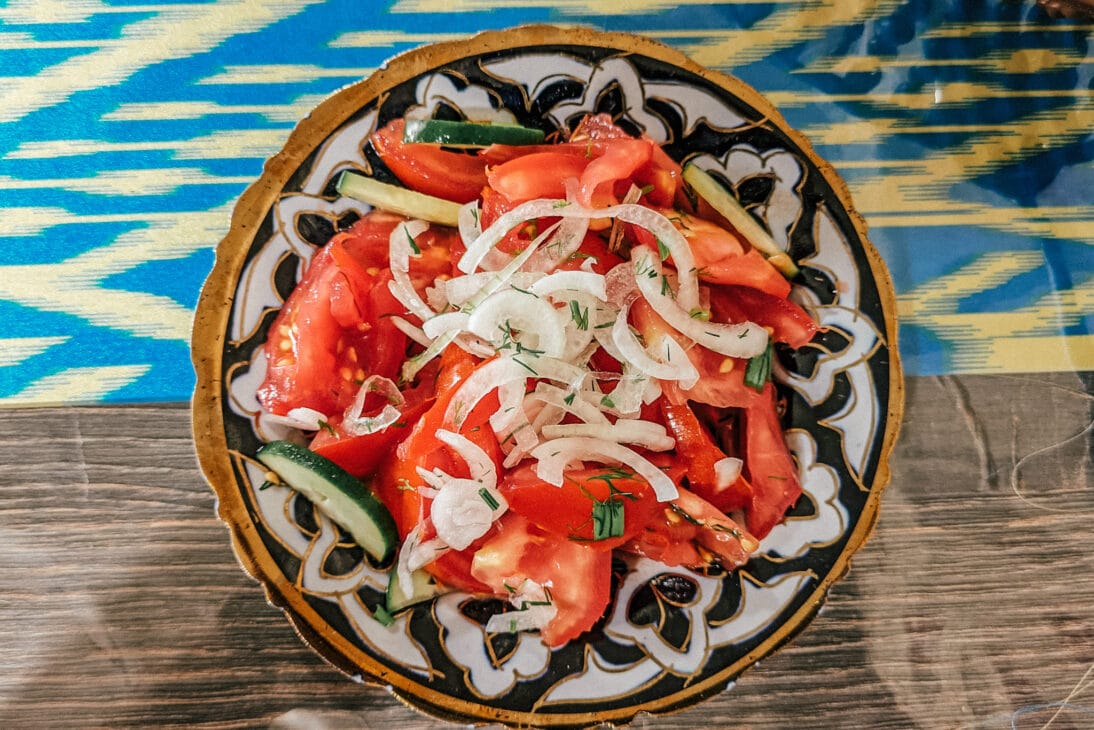
Many restaurants that cater to tourists will have extensive menus with many salads robust enough to be a meal in itself. Some of the salad combinations are very creative. They don’t appear to be traditional local salads, and were unlike anything I’ve seen elsewhere either. We had a few salads show up at our table looking nothing like what we expected. They might not be that healthy, they are tasty though!

Best food experiences in Uzbekistan
Visiting the Central Asian Pilaf Centre
One of the best things to do in Tashkent to get an idea of local Uzbek food culture is to visit the Central Asian Pilaf Centre or Plov Centre.
Here you can watch the talented chefs prepare plov in a huge kazan. There are also bakers making traditional non bread in equally huge wood-fired ovens.
The restaurant attached seats hundreds of people and is always bustling around lunch time.
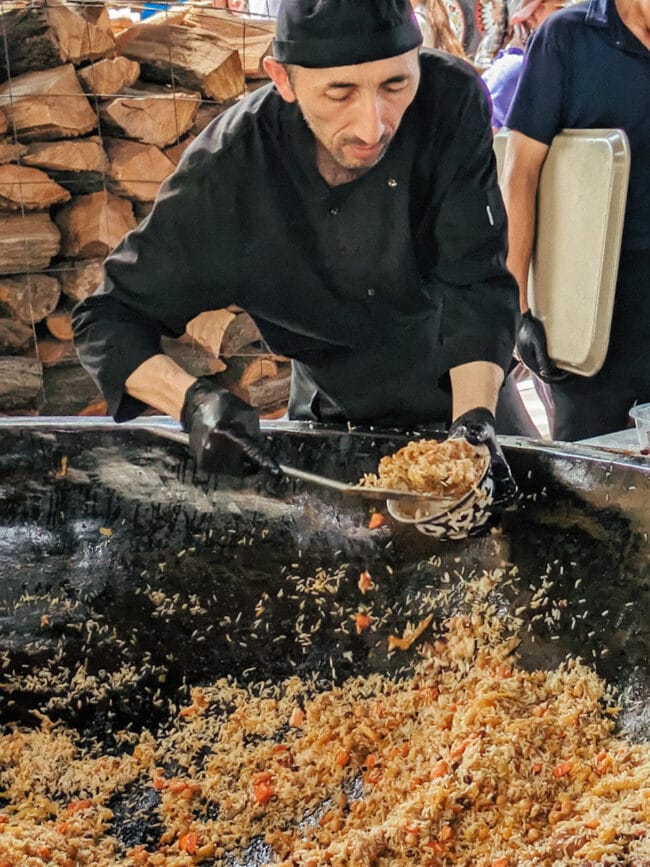

Shared menu at Terrassa Cafe in Khiva
Inside Itchan Kala in Khiva there is a restaurant called Terrassa Cafe and Restaurant.
Not only does this restaurant have one of the best views of any restaurant in Uzbekistan, overlooking Itchan Kala west gate, they do a dish where you can sample 8 different national foods in tapas size portions.
Sakkis Ta’m includes 8 small portions of local foods, perfect for 2 people to share. If you want a quick introduction to Uzbek food, or if you don’t want to risk ordering a full portion of something you may not enjoy, this meal is a great option.
Sampling nuts, dried fruits and local sweets at the bazaar
One of my favourite introductions to Uzbek food was a visit to a stand at the bazaar in Bukhara that sold an array of dried fruits, nuts and halva. Most stall owners are happy for you to taste test a few things before you buy.
At most bazaars, you will see small stores that have nuts or spices out the front, but also have an air-conditioned store that keeps delicious sweets such as chocolate covered cashews or yoghurt covered pistachios. Again, if you show some interest in buying, the owner will generally give you different things to taste test.
My favourite were hazelnuts covered in a dried pomegranate yoghurt which were to die for! I think about these almost daily.
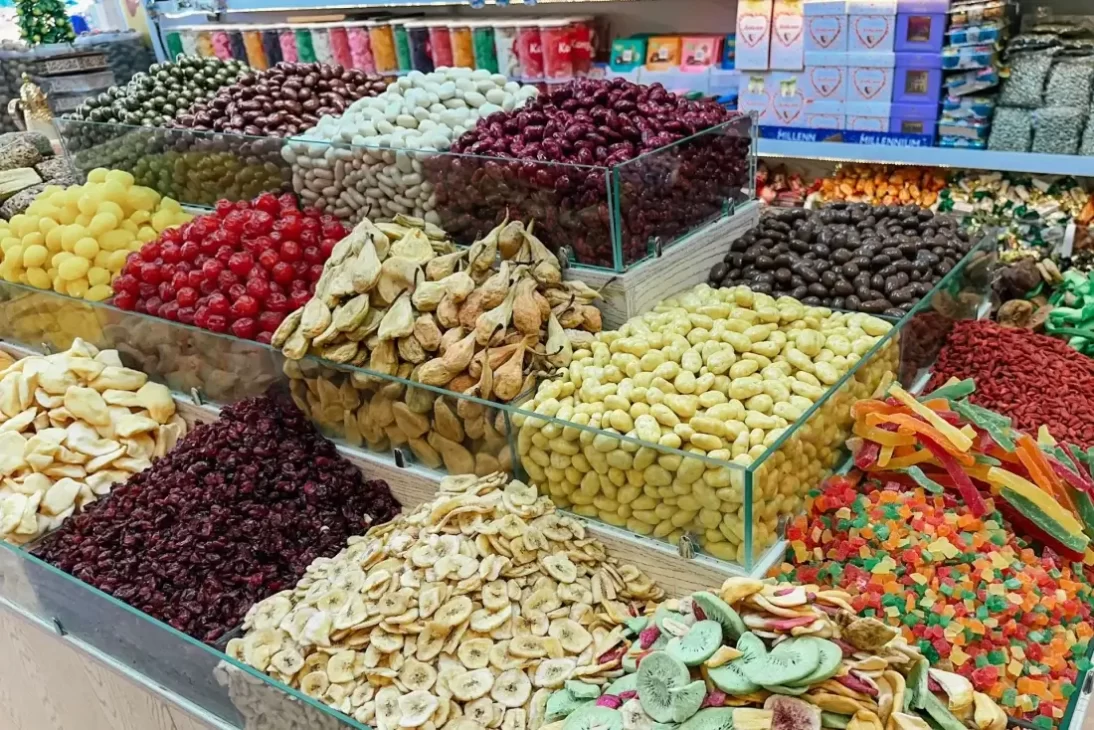
Cooking classes for Uzbekistan cuisine
If you’re interested in learning to cook Uzbek food, consider taking a cooking class with a local.
I love to take cooking classes when travelling, primarily for the opportunity to spend time with a local person and learn about something important to them. They often include market tours so you can ask questions about the unique things for sale.
This cooking class in Samarkand takes place in a family home and teaches you how to make a traditional plov from scratch.
Like it? Pin for later!


Looking for more inspiration for travelling in Uzbekistan?
The Best Things to do in Khiva, Uzbekistan
The ultimate 3 day Tashkent itinerary
The complete Uzbekistan travel itinerary
The best time of year to visit Uzbekistan



